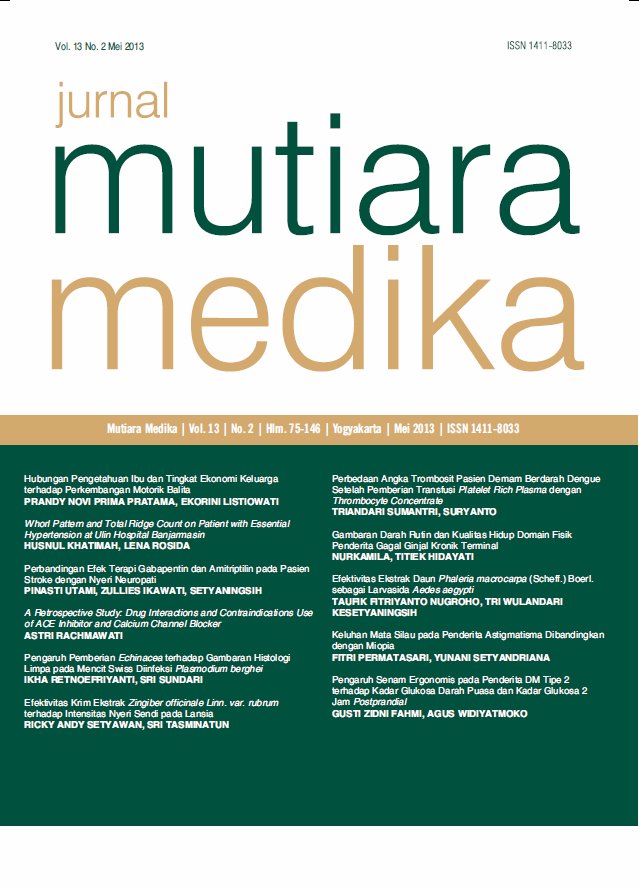Keluhan Mata Silau pada Penderita Astigmatisma Dibandingkan dengan Miopia
DOI:
https://doi.org/10.18196/mmjkk.v13i2.1064Keywords:
mata silau, miopia, astigmatisma, ambient lighting, myopiaAbstract
Astigmatisme merupakan kelainan refraksi dimana pembiasan pada meridian yang berbeda tidak sama akibat kelainan kelengkungan di kornea. Pada mata dengan astigmatisme lengkungan jari-jari pada satu meridian kornea lebih panjang daripada jari-jari meridian yang tegak lurus dimana dalam hal ini keluhan silau bisa terjadi jika kecerahan dari suatu bagian dari inferior jauh melebihi kecerahan yang berlebihan, baik yang terlihat langsung atau melewati pantulan. Tujuan penelitian ini adalah untuk mengetahui keluhan mata silau pada penderita astigmatisma dibandingkan dengan miopia. Desain penelitian ini adalah penelitian cross sectional dengan metode deskriptif untuk membandingkan ada atau tidaknya kesilauan pada penderita astigmatisma dibandingkan dengan penderita miopia. Sebanyak 68 orang mahasiswa dengan 34 orang penderita miopia dan 34 orang penderita astigmatisma. Hasil penelitian menunjukkan responden astigmatisma yang mengeluh silau berjumlah 28 orang (82,4%) dan yang tidak mengeluh silau berjumlah 6 orang (17,6%), sedangkan responden dengan karakteristik miopia yang mengeluh silau berjumlah 12 (35,3%) dan yang tidak mengeluh silau berjumlah 22 orang (64,7%), sehingga didapatkan kejadian silau 8,167 kali lebih besar pada astigmatisma dibandingkan dengan miopia. Prevalensi astigmatisma yang mengeluh silau (82,4%) dan miopia yang mengeluh silau (35,3%). Disimpulkan bahwa didapatkan keluhan mata silau yang lebih banyak pada astigmatisma dibandingkan dengan miopia.
Astigmatisma is refraction disorder where deviation in the meridient is different because of curve disorder in cornea. In astigmatisma, half diameter of curve in one miridian cornea is longer than upright vertical of half diameter miridian. Ambient lighting can be hapened in astigmatisma is the bright inferior has been over lighting either direk vision or reflaktion. This research aims to know ambient lighting on astigmatisma compared by miopia suffere. The design in this reasearch is cross sectional by descriptive method to compare the ambient lighting in astigmatisma patient by myopia patient. The respondent is 68 students and 34 respondent are myopia patient, 34 respondent are astigmatisma patient. The result shows female respondents is 38 students (55,9%) and male respondent is 30 students (44,1%). The astigmatisma respondent are 34 students (50,0%) and myopia respondent are 34 students (50,0%), ambient lighting respondents are 40 students (58,8%) and the respondents who don’t have ambient lighting are 28 students (41,2%). Astigmatisma respondent who have ambient lighting are 28 students (82,4 %) and astigmatisma respondents who don’t have ambient lighting are 12 students (35,3%) and the respondents by myopia characteristic who don’t have ambient lighting are 22 students (64,7%). Astigmatisma prevalents by ambient lighting is 82,4 % and myopia by ambient lighting is 35,3%. It can be concluded that there is ambient lighting in astigmatisma more than myopia.
References
Judarwanto, W. Penyakit Mata pada Anak. 2009. Diakses dari http://childrenclinic. wordpress.com/2009/08/20/penyakit-matapada-anak/ pada 1 Maret 2010.
Curtin. B., J. The Myopia. Philadelphia: Harper & Row. 348-381. 2002.
Konstantopoulos A, Yadegarfar G, Elgohary M. Near Work, Education, Family History, and Myopia in Greek Conscripts. Eye (Lond). 2008; 22 (4): 542-6.
Ilyas, S. Kedaruratan Dalam Ilmu Penyakit Mata. Jakarta: Balai Penerbit FKUI. 2009.
Williams W. Corneal and Refractive Anomali. Dalam: Wright K, Head MD, editor. Textbook of Ophthalomology. London: Waverly company. 1997. p. 767
Optik Nisna. Penyebab Mata Butuh Kacamata (1). 2008. Diakses pada 29 April 2012 dari http://www.optiknisna.info/myopia.html
Ilyas, S. Masalah Kesehatam Mata Anda dalam Pertanyaan-pertanyaan, Jakarta: Fakultas Kedokteran Universitas Indonesia. 1989.
Ilyas, S. Kelainan Refraksi dan Kacamata, Edisi kedua, Jakarta: Fakultas Kedokteran Universitas Indonesia. 2006.
Pheasant, S. Ergonomic Work and Health. Maryland USA: Aspen Publisher Inc. 1991.
Pusat Hyperkes dan Keselamatan Kerja, Penelitian Pengaruh Komputer Pada Mata. Departemen Tenaga Kerja. Pusat Hyperkes dan Keselamatan Kerja. 1995.
Downloads
Published
Issue
Section
License
Copyright
Authors retain copyright and grant Mutiara Medika: Jurnal Kedokteran dan Kesehatan (MMJKK) the right of first publication with the work simultaneously licensed under an Attribution 4.0 International (CC BY 4.0) that allows others to remix, adapt and build upon the work with an acknowledgment of the work's authorship and of the initial publication in Mutiara Medika: Jurnal Kedokteran dan Kesehatan (MMJKK).
Authors are permitted to copy and redistribute the journal's published version of the work (e.g., post it to an institutional repository or publish it in a book), with an acknowledgment of its initial publication in Mutiara Medika: Jurnal Kedokteran dan Kesehatan (MMJKK).
License
Articles published in the Mutiara Medika: Jurnal Kedokteran dan Kesehatan (MMJKK) are licensed under an Attribution 4.0 International (CC BY 4.0) license. You are free to:
- Share — copy and redistribute the material in any medium or format.
- Adapt — remix, transform, and build upon the material for any purpose, even commercially.
This license is acceptable for Free Cultural Works. The licensor cannot revoke these freedoms as long as you follow the license terms. Under the following terms:
Attribution — You must give appropriate credit, provide a link to the license, and indicate if changes were made. You may do so in any reasonable manner, but not in any way that suggests the licensor endorses you or your use.
- No additional restrictions — You may not apply legal terms or technological measures that legally restrict others from doing anything the license permits.






